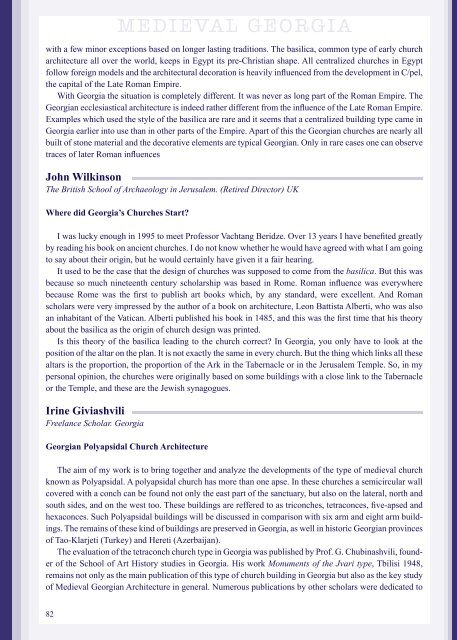Abstracts - International Initiative for Georgian Cultural Studies
Abstracts - International Initiative for Georgian Cultural Studies
Abstracts - International Initiative for Georgian Cultural Studies
Create successful ePaper yourself
Turn your PDF publications into a flip-book with our unique Google optimized e-Paper software.
with a few minor exceptions based on longer lasting traditions. The basilica, common type of early church<br />
architecture all over the world, keeps in Egypt its pre-Christian shape. All centralized churches in Egypt<br />
follow <strong>for</strong>eign models and the architectural decoration is heavily influenced from the development in C/pel,<br />
the capital of the Late Roman Empire.<br />
With Georgia the situation is completely different. It was never as long part of the Roman Empire. The<br />
<strong>Georgian</strong> ecclesiastical architecture is indeed rather different from the influence of the Late Roman Empire.<br />
Examples which used the style of the basilica are rare and it seems that a centralized building type came in<br />
Georgia earlier into use than in other parts of the Empire. Apart of this the <strong>Georgian</strong> churches are nearly all<br />
built of stone material and the decorative elements are typical <strong>Georgian</strong>. Only in rare cases one can observe<br />
traces of later Roman influences<br />
John Wilkinson<br />
The British School of Archaeology in Jerusalem. (Retired Director) UK<br />
Where did Georgia’s Churches Start?<br />
I was lucky enough in 1995 to meet Professor Vachtang Beridze. Over 13 years I have benefited greatly<br />
by reading his book on ancient churches. I do not know whether he would have agreed with what I am going<br />
to say about their origin, but he would certainly have given it a fair hearing.<br />
It used to be the case that the design of churches was supposed to come from the basilica. But this was<br />
because so much nineteenth century scholarship was based in Rome. Roman influence was everywhere<br />
because Rome was the first to publish art books which, by any standard, were excellent. And Roman<br />
scholars were very impressed by the author of a book on architecture, Leon Battista Alberti, who was also<br />
an inhabitant of the Vatican. Alberti published his book in 1485, and this was the first time that his theory<br />
about the basilica as the origin of church design was printed.<br />
Is this theory of the basilica leading to the church correct? In Georgia, you only have to look at the<br />
position of the altar on the plan. It is not exactly the same in every church. But the thing which links all these<br />
altars is the proportion, the proportion of the Ark in the Tabernacle or in the Jerusalem Temple. So, in my<br />
personal opinion, the churches were originally based on some buildings with a close link to the Tabernacle<br />
or the Temple, and these are the Jewish synagogues.<br />
Irine Giviashvili<br />
Freelance Scholar. Georgia<br />
<strong>Georgian</strong> Polyapsidal Church Architecture<br />
The aim of my work is to bring together and analyze the developments of the type of medieval church<br />
known as Polyapsidal. A polyapsidal church has more than one apse. In these churches a semicircular wall<br />
covered with a conch can be found not only the east part of the sanctuary, but also on the lateral, north and<br />
south sides, and on the west too. These buildings are reffered to as triconches, tetraconces, five-apsed and<br />
hexaconces. Such Polyapsidal buildings will be discussed in comparison with six arm and eight arm buildings.<br />
The remains of these kind of buildings are preserved in Georgia, as well in historic <strong>Georgian</strong> provinces<br />
of Tao-Klarjeti (Turkey) and Hereti (Azerbaijan).<br />
The evaluation of the tetraconch church type in Georgia was published by Prof. G. Chubinashvili, founder<br />
of the School of Art History studies in Georgia. His work Monuments of the Jvari type, Tbilisi 1948,<br />
remains not only as the main publication of this type of church building in Georgia but also as the key study<br />
of Medieval <strong>Georgian</strong> Architecture in general. Numerous publications by other scholars were dedicated to<br />
82<br />
MEDIEVAL GEORGIA



